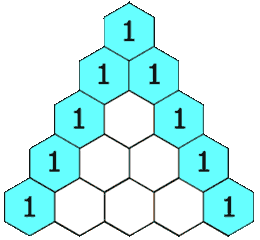Friday, September 8th
Pascal's triangle
Given an integer n, return the first n rows of Pascal's triangle
I was able to solve this in 2 different ways: iterative and recursive
For the iterative, we begin by declaring the answer vector and setting the base case when numrows=1.
Beyond that, we iterate through rows 1 at a time, calculating new values from the previous row. For each row beyond row 1 (indexed at 0), we get the previous row, then create a new row and push 1 to the front.
for(int i=1; i<numRows; i++) {
vector<int> row, prevrow;
row.push_back(1);
prevrow=ans[i-1]; ...
}
Then we new values in the new row by adding elements from the previous row
for(int i=1; i<prevrow.size(); i++) {
row.push_back(prevrow[i-1]+prevrow[i]);
}Complete the new array by pushing 1 to the end, then push the new row onto the answer vector
for(int i=1; i<numRows; i++) {
...
row.push_back(1);
ans.push_back(row);
}Finally, for the iterative approach, return the answer vector
return ans;
Full iterative solution below
A second approach to this problem is solving it recursively
First we declare a global variable that will store the answer. Then, we declare a recursive function that takes a value rownum that calculates the row for number rownum.
vector<vector<int> >ans; //global var
void recurse(int rownum) { ...
}For the recursive function, we define the base case as the first row, of row number 0, creates a vector with a sole 1 and pushes it to the solution array
if(rownum==0) {
vector<int> one;
one.push_back(1);
ans.push_back(one);
return;
}Otherwise, the function recursively calls itself for rows one less than current
recurse(rownum-1);
Once that function returns, we build a new row using the previous row. We call both these rows
vector<int> prevrow = ans[rownum-1];
vector<int> row;Then we build the current row by pushing a 1, calculating middle values based off the previous row, then pushing on a final 1
row.push_back(1);
for(int i=1; i<prevrow.size(); i++) {
row.push_back( prevrow[i-1]+prevrow[i] );
}
row.push_back(1);To complete the recursive function, we push the current row onto the solution vector
ans.push_back(row);
return;Finally, in the main function, call the recursive function and then return the solution vector
vector<vector<int>> generate(int numRows) {
recurse(numRows-1);
return ans;
}Full recursive solution below
vector<vector<int> >ans; //global var
void recurse(int rownum) {
if(rownum==0) {
vector<int> one;
one.push_back(1);
ans.push_back(one);
return;
}
recurse(rownum-1);
vector<int> prevrow = ans[rownum-1];
vector<int> row;
row.push_back(1);
for(int i=1; i<prevrow.size(); i++) {
row.push_back( prevrow[i-1]+prevrow[i] );
}
row.push_back(1);
ans.push_back(row);
return;
}
vector<vector<int>> generate(int numRows) {
recurse(numRows-1);
return ans;
}
Pretty easy problem. They call it dynamic programming but it doesn't seem like it when you have to return the entire collection of rows. Pleased I could solve it recursively in addition to the more intuitive iterative approach. Did some research into binomial coefficients and Pascal's triangle, got refreshed in equations for combinations and permutations. Looked into the beta function in C++ for generating coefficients
Comments
Post a Comment